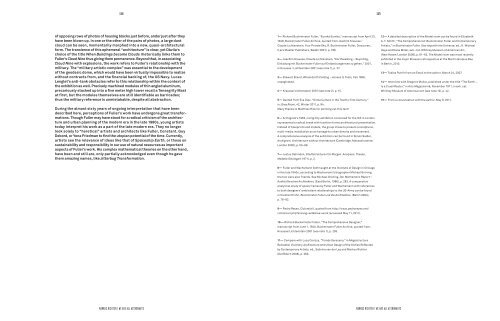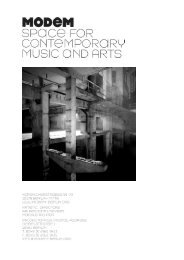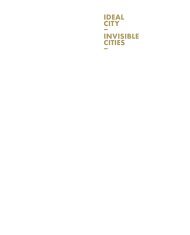MARKUS RICHTER JITTERBUG vARIATIONEN BUCKMINSTER ...
MARKUS RICHTER JITTERBUG vARIATIONEN BUCKMINSTER ...
MARKUS RICHTER JITTERBUG vARIATIONEN BUCKMINSTER ...
Erfolgreiche ePaper selbst erstellen
Machen Sie aus Ihren PDF Publikationen ein blätterbares Flipbook mit unserer einzigartigen Google optimierten e-Paper Software.
114 115<br />
of opposing rows of photos of housing blocks just before, andor just after they<br />
have been blown up. In one or the other of the pairs of photos, a large dust<br />
cloud can be seen, momentarily morphed into a new, quasi-architectural<br />
form. The transience of this ephemeral “architecture” is clear, yet Dávila‘s<br />
choice of the title When Buildings become Clouds rhetorically links them to<br />
Fuller’s Cloud Nine thus giving them permanence. Beyond that, in associating<br />
Cloud Nine with explosions, the work refers to Fuller’s relationship with the<br />
military. The “military artistic complex” was essential to the development<br />
of the geodesic dome, which would have been virtually impossible to realize<br />
without contracts from, and the financial backing of, the US Navy. Lucas<br />
Lenglet’s anti-tank obstacles refer to this relationship within the context of<br />
the exhibition as well. Precisely machined modules of thin angled aluminum,<br />
precariously stacked up into a five meter high tower recall a Tensegrity Mast<br />
at first, but the modules themselves are still identifiable as barricades;<br />
thus the military reference is unmistakable, despite all abstraction.<br />
During the almost sixty years of ongoing interpretation that have been<br />
described here, perceptions of Fuller’s work have undergone great transformations.<br />
Though Fuller may have stood for a radical criticism of the architecture<br />
and urban planning of the modern era in the late 1980s, young artists<br />
today interpret his work as a part of the late modern era. They no longer<br />
look solely to “heretical” artists and architects like Fuller, Constant, Guy<br />
Debord, or Yona Friedman to find the utopian potential of the time. Currently,<br />
artists see the relevance of ideas like that of Spaceship Earth, or those on<br />
sustainability and responsibility in our use of natural resources as important<br />
aspects of Fuller’s work. His complex mathematical theories on the other hand,<br />
have been and still are, only partially acknowledged even though he gave<br />
them amazing names, like Jitterbug Transformation.<br />
1— Richard Buckminster Fuller, “Eureka Eureka,” manuscript from April 23,<br />
1948, Buckminster Fuller Archive, quoted from Joachim Krausse /<br />
Claude Lichtenstein, Your Private Sky, R. Buckminster Fuller, Discourse,<br />
(Lars Mueller Publishers, Baden 2001), p. 188.<br />
2— Joachim Krausse, Claude Lichtenstein, “Earthwalking – Skyriding,<br />
Einladung mit Buckminster Fuller auf Entdeckungsreise zu gehen,” 2001,<br />
in Krausse / Lichtenstein 2001 (see note 1), p. 27.<br />
3— Stewart Brand, Whole Earth Catalog – Access to Tools, Fall 1968,<br />
unpaginated.<br />
4— Krausse/Lichtenstein 2001 (see note 2), p. 15.<br />
5— Quoted from Eva Diaz, “Dome Culture in the Twenty-first Century,”<br />
in: Grey Room, 42, Winter 2011, p. 84.<br />
Many thanks to Matthias Rick for pointing out this text!<br />
6— Archigram’s 1963, Living City exhibition conceived for the ICA in London<br />
represented a radical break with tradition forms architectural presentation.<br />
Instead of blueprints and models, the group chose to present a sculptural,<br />
multi-media installation as an homage to urban density and movement.<br />
A comprehensive analysis of the exhibition can be found in Simon Sadler,<br />
Archigram. Architecture without Architecture (Cambridge, Massachusetts/<br />
London 2005), p. 53–89.<br />
7— Justus Dahinden, Stadtstrukturen für Morgen. Analysen, Thesen,<br />
Modelle (Stuttgart 1971), p. 2.<br />
8— Fuller and Wachsmann both taught at the Institute of Design in Chicago<br />
in the late 1940s, according to Wachsmann’s biographer Michael Grüning<br />
the two were also friends. See Michael Grüning, Der Wachsmann Report –<br />
Auskünfte eines Architekten, (East Berlin, 1986), p. 283. A comparative<br />
analytical study of space frames by Fuller and Wachsmann with references<br />
to both designers’ ambivalent relationships to the US-Army can be found<br />
in Carsten Krohn, Buckminster Fuller und die Architekten, (Berlin 2004),<br />
p. 78–82.<br />
9— Pedro Reyes, Ciclomóvil, quoted from http://www.pedroreyes.net/<br />
ciclomovil.php?szLang=en&Area=work (accessed May 11, 2011).<br />
10— Richard Buckminster Fuller, “The Comprehensive Designer,”<br />
manuscript from June 1, 1940, Buckminster Fuller Archive, quoted from:<br />
Krausse/Lichtenstein 2001 (see note 1), p. 258.<br />
11— Compare with Luca Cerizza, “Tomás Saraceno,” in Megastructure<br />
Reloaded. Visionary Architecture and Urban Design of the Sixties Reflected<br />
by Contemporary Artists, ed., Sabrina van der Ley and Markus Richter<br />
(Ostfildern 2008), p. 260.<br />
markus richter / We are all astronauts markus richter / We are all astronauts<br />
12— A detailed description of the Model room can be found in Elizabeth<br />
A. T. Smith, “The Comprehensivist: Buckminster Fuller and Contemporary<br />
Artists,” in Buckminster Fuller. Starting with the Universe, ed., K. Michael<br />
Hays and Dana Miller, exh. cat. Whitney Museum of American Art,<br />
(New Haven/London 2008), p. 61–62. The Model room was most recently<br />
exhibited in the major Eliasson retrospective at the Martin Gropius Bau<br />
in Berlin, 2010.<br />
13— Tobias Putrih from an Email to the author, March 24, 2007.<br />
14— Interview with Gregoire Muller, published under the title “The Earth …<br />
Is a Cruel Master,” in Arts Magazine 46, November 1971, in exh. cat.<br />
Whitney Museum of American Art (see note 12), p. 42.<br />
15— From a conversation with the author, May 9, 2011.





